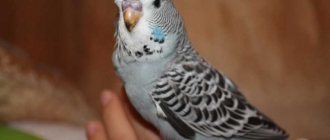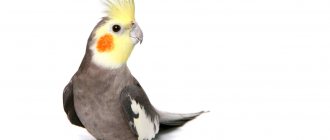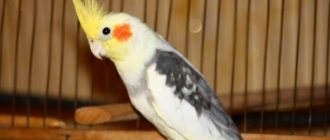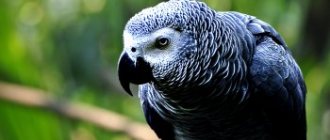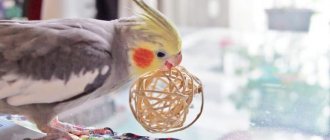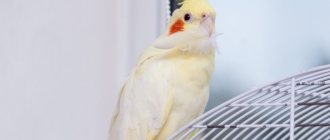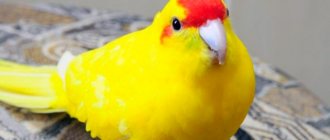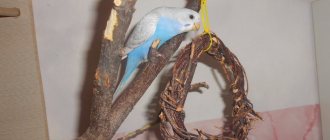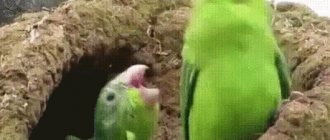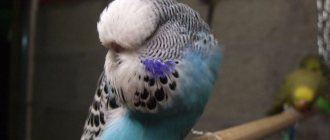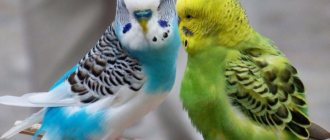Representatives of birds belonging to budgerigars or cockatiels are distinguished by their peaceful nature and get along easily with other bird species. Often relationships work out so well that the birds can even become friends. The cages can be placed nearby, then the birds will be able to see each other every day.
Nothing bad will happen if the parrots are given the opportunity to spend some time together by letting them out of their cages. One of the owners must ensure that the birds do not quarrel.
Why shouldn't a cockatiel and a budgie live in the same cage?
There is a high probability that these individuals will quarrel or fight. From time to time, conflict situations arise between individuals of the same species, so one should not be surprised at the complex relationships when parrots of different species live together.
Usually, during the process of being isolated in a cage for more than 14 days, the bird develops an understanding that this is already its private property. Naturally, she does not welcome the appearance of a new “cellmate” nearby, regarding this as an encroachment on the living space. Cockatiels, with their impressive body size and muscle strength, have a quiet character.
The cockatiel has a sufficiently large reserve of patience not to respond to the provocative antics of its wavy fellow for a long time. When a bully, as they say, crosses the line, he risks, at best, getting a paw injury, and at worst, losing it altogether. Corella is capable of giving a crushing rebuff with the help of its powerful beak. On the contrary, a correl that finds itself in the same cell with small “wavy creatures” also has a hard time - they will attack the giant in a crowd.
In the character of each individual individual, distinctive features can be identified; he has a positive attitude towards some things and a negative attitude towards others. This circumstance must also be taken into account when keeping parrots. It is not always that two individuals of the opposite sex develop harmonious relationships and reciprocate each other.
Together or Apart
Many experts do not advise placing anyone other than the same “wavy parrots” with a budgerigar, for reasons that we will describe below. You can have different birds, but it is best if each pet has its own cage.
Of course, feathered pets living in separate cages manage to make friends during “free” walks around the room. They can happily play together on the playground or sit on their owner's arm. Sometimes one bird easily “moves” to live with a neighbor without unnecessary hysterics on his part. But this is most likely the exception rather than the rule.
However, despite the recommendations of experienced breeders, some owners practice cohabitation of different birds. And often such a solution leads to various problems. Not every cage owner will happily accept a stranger, especially if he has lived there alone for a long time.
Feeding difficulties
If there are two or more parrots in the house, then it is advisable for them to select a different menu based on the species and individual characteristics. For this reason, the food needs of budgies and cockatiels are met differently.
Therefore, they have to eat together, then, quite likely, one of them will get more components important for the body, and the other, on the contrary, less. In other words, there will be a situation of nutrient imbalance, and, as a result, the preconditions for diseases will arise.
In order for the digestive process to proceed normally, birds must periodically swallow small pebbles (so-called gastroliths). Corellas and “wavy birds”, which have different dimensions and weight, require gastroliths of different fractions.
Who is suitable as a neighbor?
If the owner of a budgerigar wants to diversify the pet’s life by adding another bird to it, then in no case should you choose parrots such as gray parrots, necklaces or lovebirds. These feathered pets are too large for the “wavy” and can harm them. If a fight breaks out, the larger birds will win, possibly seriously injuring the losing parrot. And an injury such as a broken leg is very serious.
It is best to choose canaries or finches as friends for budgies. But the most popular neighbors of wavy pets are cockatiels. Although they are birds of medium build, cockatiels are quite capable of calmly communicating with “wavy birds” in the same room and on the same playground.
Before buying another feathered pet, you need to understand whether a budgie needs a pair from a bird of a different species. Let's see if cockatiels and budgies can get along in the same cage.
Risk of infection
Each of the two different species of parrots is at risk of becoming infected from each other. Being in the same cage, they are constantly in contact, drink water and eat using common utensils. All birds are susceptible to diseases under such conditions, and individual treatment is not possible.
Is it realistic for each parrot to receive its own dose of a medicine or vitamin? Basically, according to the instructions, these products are added in portions along with food or water, taking into account the weight of the parrot.
A few reasons against
Quarreling
Even between two identical feathered pets, hostility can arise. What can we say about different types of birds? A pair of birds such as a budgerigar and a cockatiel may simply not get along in the same cage. Especially if one bird is suddenly and without preparation placed with another.
When a parrot lives in a cage for more than two to three weeks, it begins to consider it its territory. Gradually the pet gets used to doing without its fellows. The sudden appearance of a neighbor can unsettle him from his usual lonely life and lead to a quarrel.
Also, future communication will depend on the individual characteristics of each specific bird. Some pets get along easily and quickly, while others may dislike each other once and for all.
Difficulties in selecting a cage
Difficulties arise with choosing a cage that would simultaneously meet the requirements of both the cockatiel and the budgie. The reason for this is the difference in the size of the parrots’ bodies and the nuances related to the design of the cage.
The fact is that when making large cages, the distance between adjacent rods is left such that a large bird cannot squeeze through them. But for a smaller parrot, this arrangement of rods cannot serve as a reliable barrier. At the very least, the “wavy” will constantly stick its head out of curiosity. This often causes the bird to injure its neck.
On the other hand, parrots of small species disdain fences with sparsely spaced bars. The birds strive to break free, accelerating in flight and hitting the bars.
Inside, the cage for cockatiels and budgies is arranged differently, again adapting to the dimensions of its inhabitants. In particular, this applies to toys, drinking bowls (wide or narrow), drinking bowls (deep or shallow). First of all, the perches (more precisely, the thickness of the sticks) must be adjusted to the size of the parrot’s paws.
Is it any wonder why claws are destroyed and joints are bothered? It is in these simple devices for sitting that the reason lies not only for the appearance of calluses on the limbs and injuries.
Possible Shared Content Issues
It is not recommended to place a budgie and a cockatiel in the same cage, and there are a number of reasons for this. If it so happens that you have representatives of different species of parrots in your house, allocate a separate house for each of them. The birds can be periodically released to fly at the same time, observing how they get to know each other and how far their friendship goes.
It happens that the wavy bird and the cockatiel will begin to feel sympathy for each other and, in the end, will express a desire to move in together. But even in this case, it is better not to keep them together, but simply leave the cages open more often so that they can play and visit each other.
Hostility and quarrels
The main reason why birds of different species are not recommended to be kept in the same cage is that they may dislike each other. The situation is especially dangerous when one parrot has already been living in your home for some time, and a second one is added later. The bird, who has lived in the cage for about 2 weeks, considers himself its full and sole owner. When one fine day another bird moves in with him, he may perceive this as an invasion of his personal space and become aggressive.
Cockatiels are more peaceful parrots. They are calm and rarely start fights. Wavys most often have an obstinate, cocky character. With their impudent behavior, they can easily provoke a conflict, “get” the cockatiel to such an extent that his golden patience will come to an end. The main danger is that the budgie will suffer from this. The dimensions of the cockatiel are much larger. With its powerful beak, the parrot can easily injure the provocateur: it can injure the cornea, beak, or bite the paw. As a result, the victim will need the help of a veterinarian.
Difficulties in feeding different birds
In general, the diet of both types of parrots is quite similar. The basis of nutrition is grain crops, such as millet, oats, and wheat. They love sunflower seeds, corn, and flaxseed. Nuts, vegetables, fruits, and herbs are given as additives. The problem may be that it is not possible to create a balanced diet for each specific bird.
Another problem is the delivery of vitamins, which caring owners give to parrots during molting, hatching eggs, etc. In this case, one bird may consume a lot of a useful supplement, while another may not receive it at all.
Cell selection
If your birds of different species are determined to live together, you will have a new problem in providing suitable conditions. Now, most likely, you will have to arm yourself with tools, materials and make a cage with your own hands, since it is very difficult to find a suitable house on sale. The fact is that budgerigars are suited to a small cage with frequent twigs, while cockatiels need a large house where the bird will feel comfortable.
The problem of relationships in birds of different sexes
What happens in the case when only an individual of the opposite sex, who is a representative of a different species, is nearby to create a married couple? Of course, the female has no choice but to reciprocate her partner, but her body will experience stress, and due to calcium deficiency, the eggs are often unfertilized.
When in the future it is possible to bring a female together with a male of her own species, their relationship will not be cloudless.
From all of the above, we can draw the following conclusion. Only short-term keeping of a cockatiel and a budgerigar together is allowed, and their relationship should not be hostile.
Description
Budgerigars
As everyone probably knows, these are bright, small birds, a little larger than an ordinary sparrow. The length of their body rarely reaches 20-21 cm; as a rule, it is much less. However, this species of the Parrot family seems larger due to its rather long tail (up to 10 cm).
Possibility of cohabitation between a cockatiel and a budgerigar
In their natural habitat, their color is predominantly grass-green, with variegated gray-black wings of a peculiar “wave” pattern. The same plumage on the upper part of the neck and the back of the head. Many years of selection work, however, have long brought out parrots of the most varied plumage colors - white, white-gray, pure yellow, blue. Waviness often persists, but not necessarily.
The bird is distinguished by a rather massive, strong beak for their build and a cere - a section of rough skin at its base.
These creatures are cheerful, active, sociable, but sometimes quite noisy. They have long been well adapted to living at home next to humans. They gained popularity due to the ability to “mimic” many sounds that they hear: the screams and even trills of other birds, individual words and phrases of human speech, coughing, bells, the grinding of a key in a keyhole and much more. All this makes the budgie fun to talk to and a beloved member of the family.
Budgie
Corella
This bird, otherwise called a nymph, is somewhat larger - the length of its body together with the tail is usually 30 or a little more centimeters. The crest on its head gives the bird a special elegance. It also indicates that the cockatiel belongs to the Cockatoo family.
The plumage is most often grayish with an olive tint, the head and crest are yellow, and there are bright spots on the cheeks of tangerine color. The beak is rounded and quite powerful.
The above color, of course, cannot be considered the only one. Breeders have worked hard here too: today, home zoos are home to nymph parrots of a wide variety of plumage variations.
Parrots! Cockatiel chicks and wavy baby are waiting for breakfast))
When communicating with humans, these birds are also able to remember and reproduce words and short phrases, although they are much more willing to imitate the calls of birds from the street or from their home environment.
